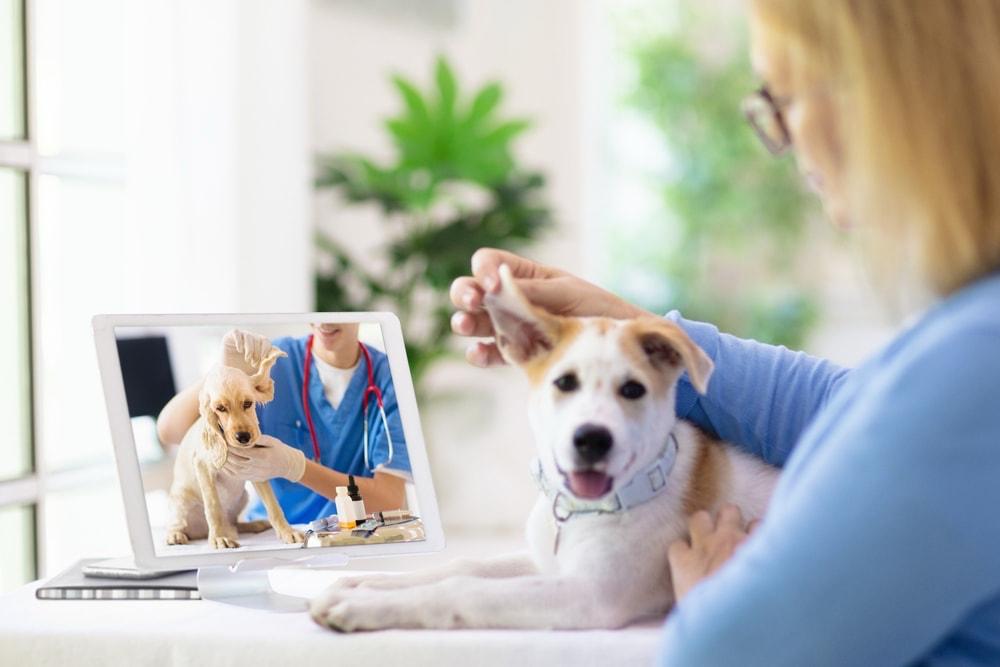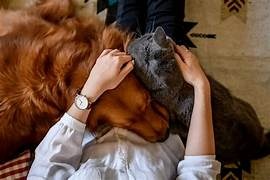
Do Pets Dream? What Science Says.
Ever wondered if your dog dreams of chasing balls or your cat dreams of hunting mice? Science reveals that pets do dream, and their nighttime adventures are more real than we think. From REM sleep to memory replay, this article explores the fascinating evidence behind animal dreams and what it means for understanding our beloved companions on a deeper level.
🐶 Pet Star
55 min read · 18, Jul 2025

Introduction
Have you ever watched your dog twitch its paws or heard your cat softly meow in its sleep and wondered—Is my pet dreaming? For pet lovers, the idea that our beloved animals might have dreams just like us is both heartwarming and intriguing. But is there any scientific evidence behind this idea, or is it just anthropomorphism? As it turns out, science has made significant strides in understanding sleep and dreaming not just in humans, but in animals too.
This article dives deep into what science tells us about pets and dreams—from sleep cycles to brain activity, and from species differences to the emotional meanings behind those adorable sleep twitches. We’ll also cover what kind of dreams pets might have, how their dreaming compares to ours, and what it all means for pet behavior and well-being.
Understanding Sleep in Animals
To understand if pets dream, we must first look at how animals sleep. Like humans, many animals, including mammals and birds, experience different sleep stages—namely Non-Rapid Eye Movement (NREM) and Rapid Eye Movement (REM) sleep.
- NREM Sleep: This is the deep, restorative stage where the body relaxes and repairs itself.
- REM Sleep: This stage is associated with dreaming in humans. The eyes move rapidly under closed eyelids, and the brain becomes highly active while the body remains mostly still.
Scientific studies have shown that pets such as dogs, cats, rodents, birds, and even some reptiles experience both NREM and REM sleep, although the duration and intensity can vary by species, age, and health.
The Science Behind Animal Dreaming
In the 1960s, Michel Jouvet, a French neuroscientist, conducted pioneering research on sleep in cats. He discovered that during REM sleep, cats exhibited twitching movements and brain activity remarkably similar to that seen in dreaming humans.
Later, a study by researchers at MIT in 2001 focused on rats. These rats were trained to run through mazes during the day, and their brain activity was recorded. Amazingly, when the rats slept, their brains showed the exact same neural patterns during REM sleep as when they were navigating the maze. This suggested they were "replaying" their day—a clear indication of dreaming.
If rats can dream, it's highly likely that more complex animals like cats and dogs do too.
Do Dogs Dream?
Yes, science strongly suggests that dogs dream.
Dr. Stanley Coren, a professor of psychology and expert in canine behavior, believes that dogs not only dream but their dreams may mirror their daily lives, much like humans. A small dog like a Chihuahua might dream every 10 minutes, whereas a large dog like a Labrador might dream once every 90 minutes—but for longer durations.
Signs your dog is dreaming:
- Twitching legs or tail
- Whimpering or barking softly
- Moving eyes beneath closed lids
- Changes in breathing rate
Dogs’ dreams likely involve playing, running, or interacting with their humans. Puppies and older dogs tend to dream more frequently, possibly because of their rapidly changing brains.
Do Cats Dream?
Cats are also dreamers. In fact, they spend up to 16 hours a day sleeping, much of which is spent in REM sleep.
Studies show that cats may dream about hunting, stalking prey, or playing. Researchers have observed that sleeping cats sometimes mimic pouncing movements or make small noises, indicating they are "acting out" parts of their dreams.
Dr. Nicholas Dodman, an animal behaviorist, suggests that cats likely have emotional dreams too. For example, a cat that had a traumatic experience may relive parts of it during sleep.
What About Other Pets?
Birds:
Birds exhibit REM sleep as well. Zebra finches, in one study, showed patterns of brain activity during sleep that suggested they were "practicing" songs they learned while awake.
Rabbits and Rodents:
Rabbits and rodents such as guinea pigs and hamsters also enter REM sleep. Like the rat study mentioned earlier, they likely replay experiences in their dreams.
Reptiles and Fish:
Reptiles like bearded dragons show alternating brain wave patterns during rest that may resemble primitive sleep cycles. However, there's less consensus about whether they dream.
Fish, on the other hand, have simpler brains and no clear evidence of REM sleep, making it unlikely that they dream—at least not in a way we understand.
What Do Pets Dream About?
Though we can’t ask pets directly, behavior and brain scans offer clues. Pets likely dream about:
- Daily experiences (walks, meals, playtime)
- Emotional interactions (affection, scolding)
- Instinctual behavior (hunting for cats, herding for dogs)
- Past traumas or fears (especially in rescued animals)
Interestingly, dogs bred for specific tasks (like retrievers or police dogs) may dream more vividly about their "jobs."
Can Pets Have Nightmares?
Yes, just like humans, pets can have bad dreams.
Owners have reported pets waking up suddenly, growling or whimpering, or seeming startled. This is especially common in pets with histories of abuse or anxiety. If your pet seems distressed during sleep, the best approach is to let them wake up naturally unless they're harming themselves.
Is Dreaming Good for Pets?
Dreaming is an essential part of mental health for animals, just as it is for humans. REM sleep is believed to help with:
- Memory consolidation
- Emotional processing
- Learning and adaptation
- Stress regulation
A well-rested pet is generally happier, healthier, and better behaved.
What You Can Do to Help Your Pet Sleep Better
- Establish a routine: Predictable bedtimes reduce anxiety.
- Provide a safe, quiet sleeping area: Away from loud noises or disturbances.
- Ensure physical and mental stimulation: Active pets sleep better.
- Feed them appropriately: Avoid heavy meals right before bed.
- Comfort items: Blankets, toys, or even a piece of your clothing can help.
Have you ever watched your dog twitching its paws or your cat softly meowing in sleep and wondered—do pets actually dream like we do? The idea is both heartwarming and intriguing, and while pet owners might assume their furry companions dream of chasing balls or catching mice, science provides a growing body of evidence that animals, particularly mammals and birds, indeed experience dreams. Understanding pet dreams starts with understanding their sleep cycles; like humans, many animals—including dogs, cats, rodents, birds, and even reptiles—experience phases of Non-Rapid Eye Movement (NREM) and Rapid Eye Movement (REM) sleep, with REM being the stage most closely associated with dreaming. Scientific studies, especially those conducted on rats and cats, have offered groundbreaking insights into this topic. In the 1960s, French neuroscientist Michel Jouvet studied REM sleep in cats and discovered brain activity and muscle twitches similar to human dream states, concluding that cats likely experience dreams during REM. Fast forward to 2001, when researchers at MIT trained rats to run mazes and recorded their brain activity during the process; what they found was astonishing—the same neural patterns observed during their waking maze exploration reappeared when the rats were in REM sleep, strongly suggesting they were replaying their daily experiences and therefore dreaming. Given that rats, which are cognitively less complex than dogs or cats, can dream, it is a logical extension that pets with more advanced brains not only dream but might experience dreams more vivid and emotional in nature. Dogs, for instance, exhibit frequent REM sleep, especially puppies and older dogs whose brains are either rapidly developing or gradually declining, leading researchers to believe they dream more often. Behaviorists like Dr. Stanley Coren suggest dogs likely dream about common daily occurrences—playing fetch, going for walks, interacting with their humans—since their brain structures, including the hippocampus (associated with memory and learning), are remarkably similar to humans'. Observing a dreaming dog might reveal twitching paws, gentle growls, or soft barking, and their eye movement beneath closed lids aligns with REM sleep. Dogs of different sizes exhibit different sleep patterns: small breeds might dream every ten minutes with short dream episodes, while larger breeds like Golden Retrievers might have dreams less frequently but for longer durations. Cats, on the other hand, are master sleepers, often clocking in 13 to 16 hours of sleep per day, much of which involves REM cycles. Feline sleep behavior suggests that cats may dream about stalking, hunting, or playing, evident from their tail flicks, paw movements, and occasional meows during sleep. Dr. Nicholas Dodman, a veterinary behaviorist, believes cats, too, experience emotionally charged dreams, especially those who’ve endured trauma or significant changes in their environment. The scope of dreaming extends beyond cats and dogs; birds, notably zebra finches, have demonstrated the ability to replay learned songs during sleep, with brain activity during REM closely mimicking that of their waking song practice—an insight suggesting they “rehearse” while asleep. Rabbits, guinea pigs, and other small mammals have also displayed REM sleep, often accompanied by twitching or rapid breathing, signaling potential dream activity. Reptiles like bearded dragons have shown alternations in brainwave patterns during rest that may hint at primitive sleep stages, although it’s less clear whether these phases equate to dreams as we understand them. Fish, on the other hand, lack the complex brain structures and REM activity that support dreaming, making it unlikely that they dream in the human or mammalian sense. What, then, do pets dream about? While we can't enter their minds, studies and behavior suggest pets dream about experiences drawn from daily life—dogs running in parks, cats chasing imaginary prey, or birds practicing songs. Emotionally sensitive or traumatized animals may even relive stressful events, which points toward the possibility of nightmares. Many pet owners have observed signs of distress during sleep: growling, whining, sudden jolts, or waking in fear, especially in rescue animals with troubled pasts. While tempting, it is generally advisable not to wake a pet in the middle of a dream or nightmare, as abrupt awakenings can lead to confusion or defensive behavior. From a neurological perspective, dreaming serves important functions—REM sleep, in both humans and animals, is vital for memory consolidation, emotional regulation, cognitive development, and stress reduction. When pets are deprived of restful sleep or REM cycles, they may exhibit behavioral issues, irritability, or learning difficulties. Ensuring that pets have a quiet, comfortable, and safe environment to sleep deeply supports not only their physical health but also their mental and emotional well-being. A proper sleep routine—free from loud disturbances, with familiar bedding, toys, and adequate daily exercise—goes a long way in promoting quality rest. Dreaming, in essence, may act as a therapeutic replay mechanism that helps pets make sense of their world, just as it does for humans. Interestingly, certain breeds or species with strong working instincts, like herding dogs or hunting cats, might experience dreams rich in action, driven by their innate behavior patterns. On the other hand, domesticated pets that lead sedentary lives may dream more subtly, focused on bonding, feeding, or curiosity. Regardless of the specific content, the act of dreaming enriches an animal’s inner world, hinting at layers of consciousness and emotional complexity we’re only beginning to understand. In conclusion, science now affirms what many pet lovers have long suspected: pets do dream, and their dream lives reflect a blend of instinct, experience, and emotion. Through sleep studies, brain scans, and behavioral observations, researchers have shown that animals from rats to dogs to birds engage in REM sleep and likely dream in ways that parallel human dreaming. Dogs may dream of joyous play or protection; cats of the thrill of the hunt; birds of the songs they’ve learned to sing. Dreaming helps pets learn, remember, heal, and grow, underscoring just how vital rest is to their overall quality of life. So the next time you notice your dog’s paw kicking or your cat softly chirping in their sleep, smile and rest easy—they’re off in their own dream world, possibly reliving the moments they cherish most—perhaps even the ones spent with you.
While the scientific evidence supporting the presence of dreams in pets is both compelling and heartening, it also opens up a fascinating realm of inquiry into the depth and nature of those dreams, especially as they relate to emotion, memory, and learning in animals. The concept of emotional dreaming in pets, once considered purely anthropomorphic, is increasingly supported by veterinary neuroscience and behavioral studies, especially in animals that exhibit PTSD-like symptoms or have gone through emotional bonding and separation events. For example, dogs that have lost a companion or owner often show signs of distress, even in their sleep—whining, whimpering, or waking suddenly—and many experts believe these episodes may reflect grief-related dreaming or nightmares, very similar to the human experience of reliving emotional trauma. On the other hand, pets with joyful and enriched environments might often dream about positive interactions, such as playing fetch in the park or receiving affection from family members. In such cases, dreaming may not only serve as a memory replay system but also as an emotional processor, helping the animal navigate its social and internal world. This capability is not just limited to companion animals; studies have observed similar patterns in domesticated horses, dolphins, and even elephants—species known for their emotional depth and strong memory. The structure of the animal brain, especially areas like the hippocampus (memory center), amygdala (emotion regulation), and neocortex (thinking and problem-solving), further supports the possibility that animals can dream with content complexity and emotional range akin to humans, though likely at a more instinct-driven level. Dogs, for instance, have brainwave patterns during REM that mirror not only their physical actions but also signs of recognition, suggesting their dreams may include familiar people, places, or other animals. Similarly, anecdotal evidence and observational studies of cats point toward dreams centered around hunting and territory exploration—cats often “pounce” in their sleep or make rapid head and eye movements that mimic prey-tracking behavior. This is not surprising, considering that hunting is deeply embedded in feline instinct, and dreaming may be the brain's way of maintaining those survival skills even in domesticated environments. In birds, particularly parrots and finches, sleep appears to play a crucial role in vocal learning and social bonding, with REM sleep facilitating the “rehearsal” of learned songs and communication patterns. These findings hint that birds might dream of singing, flock interactions, or even environmental stimuli like light patterns or threats. As for reptiles and amphibians, the jury is still out; while brain scans have shown alternating activity patterns during rest in species like bearded dragons, conclusive evidence of REM sleep or dream-like brain function is still lacking, and further research is needed to determine whether these cold-blooded animals experience dreams in any meaningful way. Meanwhile, the question of whether pets dream about humans—especially their owners—has captured the imagination of animal lovers and scientists alike. Based on brain scans showing dogs' strong reactions to the scent and presence of their humans, as well as memory-based learning observed during waking and sleep cycles, it is highly likely that pets do dream about their favorite people. Such dreams may involve shared routines, like walking routes, feeding time, or comforting touches. This reinforces the bond between humans and animals, suggesting that the connection transcends waking consciousness and extends into their subconscious minds. From a practical standpoint, understanding and supporting healthy sleep and dream activity in pets can greatly enhance their mental well-being. Sleep deprivation or disrupted REM cycles in animals have been linked to irritability, cognitive decline, poor social interaction, and even increased aggression. For instance, a dog with insufficient REM sleep might struggle to remember commands or show signs of anxiety, while a cat deprived of its natural sleep rhythms might become withdrawn or overreactive to stimuli. Pet owners can support healthy sleep patterns by ensuring a quiet, comfortable, and consistent sleeping environment—this includes soft bedding, limited nighttime noise, dim lighting, and a routine feeding and play schedule that aligns with their pet's natural sleep-wake cycles. Just like humans benefit from good sleep hygiene, so do pets. Furthermore, mental stimulation through training, puzzle toys, and exploratory play during the day can enhance REM sleep quality at night, leading to richer, more meaningful dreams and better behavior during waking hours. The link between sleep, memory, and behavior is well-documented in animal research, and its practical applications are gaining attention in veterinary clinics, training facilities, and shelters. For example, shelter animals often experience fragmented sleep due to stress and noise, which may worsen anxiety and slow down socialization efforts. Creating dream-friendly sleep conditions—through white noise machines, aromatherapy, or dedicated quiet zones—has been shown to improve restfulness and adoption rates in many cases. On the flip side, monitoring abnormal sleep behavior such as night terrors, excessive twitching, or vocal distress can help detect underlying health issues in pets, including epilepsy, anxiety disorders, or pain. In some instances, veterinarians may use EEG (electroencephalogram) monitoring to study brain wave patterns during sleep, aiding in diagnosis and treatment plans. While most pet dreams are harmless and even charming to witness, it's important for owners to be observant and compassionate, recognizing when sleep behavior indicates deeper emotional or physical needs. As the field of animal cognition continues to evolve, our understanding of dreams in animals may become more nuanced, perhaps even bridging the gap between human empathy and interspecies communication. Some researchers are exploring the idea of “lucid dreaming” in higher mammals, while others investigate whether pets’ dreams can be influenced by their daytime experiences in intentional ways. Could a training session or positive event before bedtime shape a pet’s dream content, potentially reinforcing learning or reducing trauma? These questions open the door to a fascinating frontier in both pet psychology and human-animal relationships. In summary, the notion that pets dream is no longer a whimsical fantasy but a well-supported scientific reality. Their dreams, formed during REM sleep, reflect a complex interplay of memory, instinct, emotion, and experience. Dogs might run across grassy fields chasing familiar scents; cats may stalk imaginary mice in moonlit gardens; birds could be refining the notes of a song; and somewhere in their slumber, they might also be thinking of us—their trusted companions, caregivers, and friends. Dreams are not only a window into the unconscious minds of animals but also a testament to their cognitive richness and emotional depth. A dreaming pet is not simply at rest—it is reprocessing life, expressing identity, and navigating its inner world. As we better understand and respect this silent, soulful part of their lives, we strengthen our bond with them, acknowledging not only their physical needs but also their mental and emotional dimensions. In doing so, we don’t just become better pet owners—we become more compassionate beings, capable of seeing the unseen, hearing the unspoken, and loving without limits, awake or asleep.
Conclusion
Science has made it clear: Yes, pets do dream. From dogs chasing balls in their sleep to cats twitching their tails as they relive a hunt, dreaming is a natural and healthy part of animal life. Brain studies in rats, cats, and dogs show that animals process memories and possibly emotions while they sleep—just like humans.
Dreaming plays a critical role in your pet’s well-being. It helps them recover from the day, process their environment, and even learn new things. As pet owners, understanding this aspect of their inner world deepens our connection with them and helps us care for them better.
So next time your dog twitches in their sleep or your cat lets out a tiny meow—smile. They might just be dreaming of you.
Q&A Section
Q1:- Do pets really dream like humans do?
Ans:- Yes, scientific studies confirm that many pets experience REM sleep, which is associated with dreaming. Dogs, cats, and even birds have shown brain activity consistent with dreams.
Q2:- What do dogs dream about?
Ans:- Dogs likely dream about everyday activities like playing, running, or interacting with their owners. Their dreams often mirror their waking experiences.
Q3:- Can cats have nightmares?
Ans:- Yes, cats can experience distress during sleep, especially if they have past trauma. Signs may include twitching, growling, or waking up suddenly.
Q4:- How can I tell if my pet is dreaming?
Ans:- Look for signs like twitching paws, vocalizations, rapid eye movements under closed lids, and changes in breathing. These usually occur during REM sleep.
Q5:- Should I wake my pet during a dream or nightmare?
Ans:- It's generally best not to wake a dreaming pet unless they're in distress. Waking them suddenly can cause confusion or fear.
Similar Articles
Find more relatable content in similar Articles

Composting Pet Waste: A Greener Way to Clean Up...
As pet ownership continues to .. Read More

Virtual Vet Visits: Are Online Consultations Reliable?..
As pet healthcare embraces dig.. Read More

Social Media for Pets: Turning Your Pet into a Digital..
From playful puppies to charis.. Read More

Pets and Mental Health: The Science Behind Emotional H..
Discover the profound impact o.. Read More
Explore Other Categories
© 2024 Copyrights by rPets. All Rights Reserved.